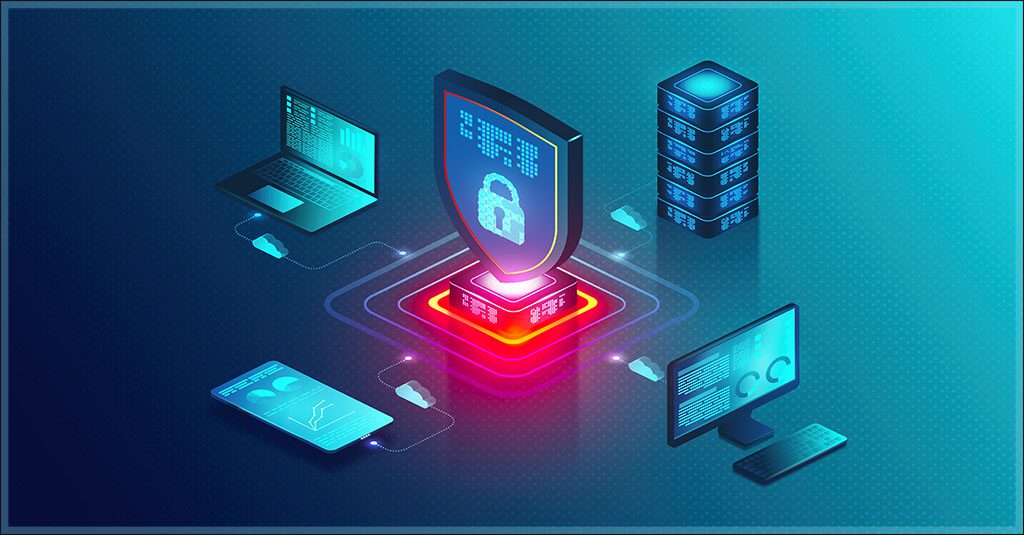The Top Target for Ransomware is Schools

Cybercriminals have learned that schools are profitable targets
Schools have become prime targets for cyberattacks, including devastating ransomware attacks. A successful ransomware attack on a K – 12 school can have an array of negative consequences that no school wants to face like jeopardizing students’ personal information, dealing a big budget hit, disrupting learning and regulatory fines. A ransomware attack can cause damage that has a far-reaching ripple effect for years into the future. However, there are steps schools can take to reduce their risk of cyber trouble.

Learn more about growing supply chain risk for businesses and how to mitigate it in a fresh eBook. DOWNLOAD IT>>
More technology in schools brings more cyber risk
K-12 education has experienced a huge amount of technological change in the last three years. The effects of the global pandemic led schools to quickly adopt distance learning. Educators also have access to a wealth of technology-focused options to leverage in the classroom. All of this technology has led to wonderful advancements in education that benefit both teachers and students. Unfortunately, it has also made schools a prime target for cyberattacks. According to the Center for Internet Security, by the end of 2022, they recorded an estimated 30% quarter-over-quarter increase in the number of cyberattacks that targeted K-12 schools.
One of the most dangerous cyberattacks that schools face is ransomware. Ransomware is malicious software that locks or encrypts a school’s systems and data demanding a payment (a “ransom”) to restore access. It’s like a digital hostage situation where the data is held captive until you pay the cybercriminals to release it. Unfortunately, ransomware is a common cyberattack, and it’s very easy for schools to come into contact with it. Forbes reports that in August 2023, researchers determined that 80% of schools in the U.S. and 14 other countries had been victims of ransomware attacks in 2022.

Explore how AI technology helps businesses mount a strong defense against phishing GET INFOGRAPHIC>>
What are the risk factors that make schools attractive targets for ransomware attacks?
While it’s important to note that specific motivations can vary, here are several risk factors that may make schools attractive targets for ransomware attacks:
- Sensitive Data: Schools store a significant amount of sensitive and personal information about students, staff, and faculty, including contact details, academic records and sometimes medical or financial information. This data is valuable, and cybercriminals can sell it on the dark web.
- Limited IT Resources: Many schools or districts may have limited budgets for cybersecurity and IT infrastructure. This makes them more vulnerable to attacks, as they might lack the necessary resources to implement the right security measures and regularly update them.
- Critical Operations Dependence: Schools rely heavily on digital infrastructure for various critical operations, such as online learning platforms, smart boards and communication systems. Disrupting these systems through ransomware can significantly impact daily operations and create pressure to pay the ransom to restore normalcy.
- Potential for Quick Payments: In the face of a ransomware attack, educational schools may feel compelled to pay the ransom quickly to minimize disruption and ensure the continuity of academic activities. Cybercriminals are more than willing to exploit this urgency for financial gain.
- Lack of Cybersecurity Awareness: Individuals within educational institutions, including students, faculty and staff may not always be well-versed in cybersecurity best practices. This lack of awareness can lead to actions that inadvertently contribute to the success of a ransomware attack, such as clicking on phishing links or downloading malicious files.
- Legacy Systems and Software: Schools may be using legacy systems and software that are no longer supported or updated. This can create vulnerabilities that hackers exploit, as outdated systems are more susceptible to cyber threats.
- Reputation Management: Most schools value their reputation in the community. This can be especially important for private schools or schools that do fundraising. The news of a cyberattack that impacts students getting out wouldn’t be good for maintaining a desirable image.
- Remote Learning Challenges: The shift to remote learning has increased the attack surface for schools, with students and staff accessing systems from various locations. This can make it challenging to implement and enforce consistent cybersecurity measures and policies.
- Critical Timelines: Schools often operate on a fixed academic calendar, with specific timelines for exams, grading and other crucial activities. Ransomware attacks can disrupt these timelines, putting additional pressure on institutions to resolve the situation quickly.

Explore the nuts and bolts of ransomware and see how a business falls victim to an attack. GET EBOOK>>
Schools face a variety of unpleasant consequences in the wake of a successful cyberattack.
Disruption of the learning environment
One of the immediate consequences of a successful cyberattack is the disruption of the learning environment. Students and teachers heavily rely on technology for educational purposes, from online classes to collaborative projects. A cyberattack can lead to the shutdown of critical systems, causing chaos and hindering the educational process. The loss of instructional time can be detrimental to students’ academic progress. According to the U.S. Government Accountability Office (GAO), The loss of learning following a cyberattack ranged from 3 days to 3 weeks, and recovery time could take anywhere from 2 to 9 months.
Data breach and privacy concerns
K-12 schools collect and store vast amounts of sensitive information about students, staff and parents. A successful cyberattack puts this data at risk, leading to a breach of privacy. Personal information, including addresses, contact details and potentially even medical records, can fall into the wrong hands. This not only compromises individuals’ privacy but also exposes them to the risk of identity theft and other forms of cybercrime. Schools are also required to comply with a number of data privacy regulations that may vary by location. The fines for noncompliance with those statutes can be very costly.
Financial implications
Incident response and the process of recovering from a cyberattack carry a significant cost. Schools may need to invest in cybersecurity experts, conduct forensic investigations, purchase solutions or equipment and implement new security measures. None of these things are cheap. The financial burden may strain already limited budgets, diverting resources from essential educational programs. Schools report monetary losses between $50,000 to $1 million if they face a cybersecurity incident, not counting any ransom paid.
Reputation damage and trust erosion in the community
A successful cyberattack can erode the trust that parents, students and the community place in the school, and rebuilding that trust becomes a challenging task. Parents may question the school’s ability to protect their children’s information. For private schools, the reputation damage caused by a ransomware attack could lead to a decline in enrollment. Donors may fear that their information could also be compromised in an attack, making them less likely to provide needed funds.
Educational inequality
Not all schools have the same resources, and a cyberattack can exacerbate existing educational inequalities. Affluent schools may recover more quickly due to better financial resources, leaving economically disadvantaged schools struggling to cope. That deficit can lead to cuts in funding for student activities like sports or music. This further widens the gap in educational opportunities and outcomes between different socio-economic groups.
Long-term psychological impact
Beyond the immediate consequences, a successful cyberattack can have a long-term psychological impact on students, teachers and administrators. The sense of violation and insecurity may linger, affecting the overall well-being of those involved. Students may develop anxiety about the safety of their personal information, and teachers may feel a sense of powerlessness in the face of digital threats.

Learn how Datto EDR satisfies cyber insurance requirements for endpoint protection & EDR. DOWNLOAD REPORT>>
8 smart actions for schools to take to prevent a cybersecurity disaster
There are a number of smart moves that schools can make to reduce their risk of falling victim to a cyberattack like ransomware.
1. Proactive cybersecurity measures: Emphasize immediate action
The first step in securing your school’s digital world is to recognize the urgency of the matter. Schools must understand that cyber threats are real and evolving. By taking immediate action to assess vulnerabilities and establish robust defenses, they can significantly reduce the risk of falling victim to cyberattacks.
2. Security awareness training: Educate your first line of defense
A well-informed staff and student body are a school’s first line of defense against cyber threats. Security awareness training is critical to help everyone in the school community recognize potential threats, from phishing emails to suspicious websites. It empowers them to make informed decisions and avoid falling into the traps set by cybercriminals.
3. Email security: Guard the gateway
Email remains one of the primary entry points for cyberattacks, and the most likely way that staffers and students will encounter ransomware. Implementing strong email security measures, including filtering, authentication and encryption, can prevent phishing attempts from reaching their targets and protect sensitive information. An artificial intelligence (AI)-enabled email security solution can effectively spot and stop phishing messages at an affordable price.
4. Endpoint security: Protect devices and data
Endpoint protection solutions, such as antivirus software and intrusion detection systems, play a vital role in safeguarding all devices connected to your network. These solutions detect and neutralize threats before they can infiltrate your systems. An endpoint detection and response (EDR) solution can quickly spot trouble and may even allow you to roll systems back to before the attack hit.
5. Patching: Keep software secure
Software vulnerabilities are a prime target for cybercriminals. Regular software updates and patch management are essential to close these vulnerabilities promptly. Failing to update your systems can leave the door wide open for attackers.
6. Security policies: Establish clear guidelines
Clear and well-defined security policies are essential for governing data handling, user access and acceptable use of resources. These policies provide a framework for consistent security practices and help mitigate risks. For example, a school may make it a requirement for every staffer to train with phishing simulations.
7. Incident response plan: Prepare for the worst
Despite your best efforts, a cyberattack can still happen. An incident response plan is your playbook for managing and mitigating the damage. It should include specific protocols for dealing with ransomware attacks, among other threats, to ensure a swift and effective response.
8. Penetration testing (Pen testing): Ethical hacking for a safer future
Penetration testing, or pen testing, involves simulating cyberattacks to identify vulnerabilities before malicious actors do. By actively seeking and remediating weaknesses a school can proactively secure its digital environment. This used to be an expensive proposition, but advances in automation have made frequent penetration testing affordable.
In an era where the digital landscape is continually evolving, the importance of cybersecurity for K-12 schools cannot be overstated. Taking these proactive measures can help schools stay one step ahead of cyber threats and create a safer digital space for students, staff and the entire educational community.
Schools can quickly & affordably mitigate cyber risk with the right solutions
Kaseya’s Security Suite equips schools with the right tools to mitigate cyber risk today without blowing up their budget while ensuring that the school is ready for the threats of tomorrow.
BullPhish ID – This effective, automated security awareness training and phishing simulation solution provides critical training that improves compliance, prevents employee mistakes and reduces a company’s risk of being hit by a cyberattack.
Dark Web ID – Our award-winning dark web monitoring solution is the channel leader for a good reason: it provides the greatest amount of protection around with 24/7/365 human and machine-powered monitoring of business and personal credentials, including domains, IP addresses and email addresses.
Graphus – Graphus is a cutting-edge, automated email security solution that puts three layers of AI-powered protection between employees and phishing messages. It works equally well as a standalone email security solution or supercharges your Microsoft 365 and Google Workspace email security.
Kaseya Managed SOC powered by RocketCyber – Our managed cybersecurity detection and response solution is backed by a world-class security operations center that detects malicious and suspicious activity across three critical attack vectors: endpoint, network and cloud.
Datto EDR – Detect and respond to advanced threats with built-in continuous endpoint monitoring and behavioral analysis to deliver comprehensive endpoint defense (something that many cyber insurance companies require).
Vonahi Penetration Testing – How sturdy are your cyber defenses? Do you have dangerous vulnerabilities? Find out with vPenTest, a SaaS platform that makes getting the best network penetration test easy and affordable for internal IT teams.

Read case studies of MSPs and businesses that have conquered challenges using Kaseya’s Security Suite. SEE CASE STUDIES>>